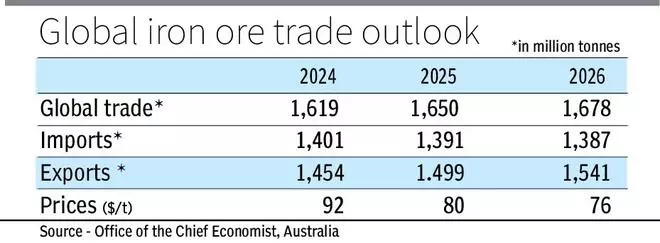Iron ore prices will likely be under continued downward pressure that could extend to 2026 due to weak demand stemming from a subdued outlook for China amid its sluggish property sector, analysts have said.
This is despite iron ore prices rising to over $105 a tonne currently on hopes that China will introduce more stimulus measures during key Politburo meetings in December.
The Trading Economics website said the Politburo’s decision to skip a readout of its regular November meeting had fueled speculation that a stimulus package could be on its way as China prepares for the return of Donald Trump as the US President next month.

Short-lived rally
Latest data show that Chinese manufacturing activity expanded for the second consecutive month in November, further strengthening the demand outlook for iron ore.
Iron ore prices had rallied during September-end too on Chinese stimulus announcements, but the rally proved to be short-lived as prices declined in early November. They struggled to breach the $100 per cent tonne mark, despite Beijing’s efforts to reinvigorate the property sector, until now.
“We maintain our 2025 iron ore price forecast at an annual average of $100/tonne, expecting continued downward pressure …,” said research agency BMI, a unit of Fitch Solutions.
From an estimated average price of around $92 a tonne (FOB) in 2024, the benchmark iron ore price is now projected to fall to an average of$80 a tonne in 2025, then decline further to around $76 a tonne in 2026, said the Australian Office of the Chief Economist (AOCE).
Weak Chinese demand
The World Bank, in its Commodity Outlook, said iron ore prices are forecast to fall further in 2025-26 as major producers expand output and new mines come online. “After an expected 10 per cent (year-on-year) drop this year, iron ore prices are projected to fall by 12 per cent in 2025 and 5 per cent in 2026,” it said.
“Prices have sharply underperformed the broader commodities index, reflecting elevated exposure to the persistent weakness in China’s construction sector and ample supply prospects,” it said.
BMI said persistent weakness in Chinese demand coupled with rising iron ore inventories has sustained downward pressure. “We expect iron ore prices to continue to be hit by a weak demand outlook, barring additional support measures from China in the coming months,” it said.
Iron ore prices are likely to remain highly sensitive to potential stimulus announcements, with market sentiment skewed towards expectations of further support in light of anticipated rekindled trade tensions under a second Trump presidency. The extent of any provided stimulus will be crucial in determining whether it can turn the tide for the iron ore market, the research agency said.
Steel production down
“Iron ore prices are likely to remain highly sensitive to potential stimulus announcements, with market sentiment skewed towards expectations of further support in the coming months,” said BMI.
On the supply side, iron ore production remains healthy across major miners, which will work to limit any potential upside for iron ore prices, it said.
Steel production in China and thus demand for iron ore still remain sluggish, with property sector weakness adding to the grim picture, said the research agency.
According to the World Steel Association, during the first nine months of 2024, China’s production of crude steel declined by 3.6 per cent year-on-year, with production in September falling by 6.1 per cent year-on-year. Production, however, staged a recovery in October.
Downside risks
The World Bank said the likelihood of continued softness in China’s property sector is expected to keep iron ore demand subdued. “Additionally, steady growth in iron ore production from Australia and Brazil— the world’s two largest producers—along with new low-cost production from West Africa, likely to come online in 2025, is expected to exert further downward pressure on prices,” it said.
BMI said outside of China, steel production and demand for iron ore remain muted so far, while on the supply side, production remains healthy across major miners.
The research agency said the downside risks to its 2025 forecast was that demand for iron ore could be capped if the Trump administration imposes significant trade tariffs on Chinese steel exports.


